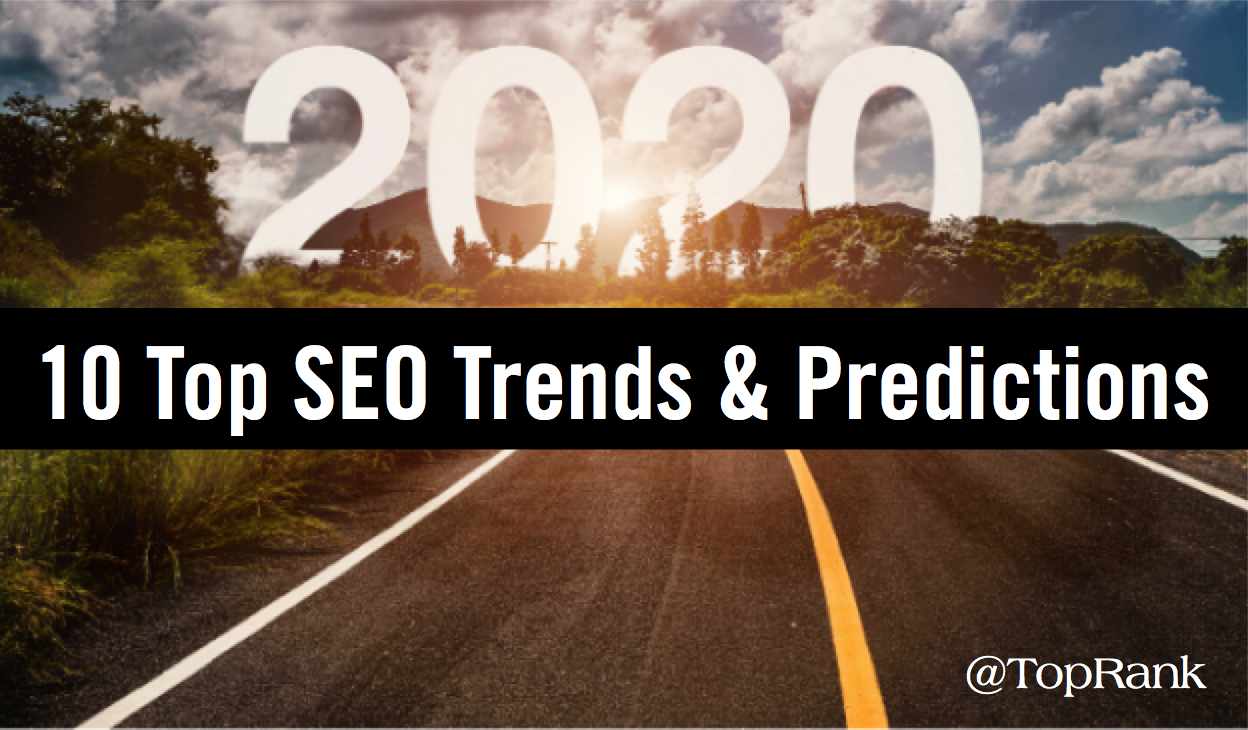|
10 Top B2B SEO Trends & Predictions for 2020
https://ift.tt/36LlebT
It’s that time of year, B2B marketers. We’re tying up loose ends. We’re reflecting on a year’s worth of wins, opportunities, and change. And we’re working hard to finalize next year’s marketing plans and budgets so we can hit the ground running after the clock strikes midnight on New Year’s Day. 2019 was a wild year for search, keeping SEOs and marketers on their toes. Multiple mobile-first indexing updates were implemented by Google. New best practices were released for structured data. Automated podcast transcription and playability within Google SERPs became a reality. And the list goes on. As we say goodbye to another year and decade of massive changes, we asked our SEO-savvy friends to join us in sharing trends to watch and predictions for what 2020 will bring to the world of search. What topped the list? From voice search and IoT to intent research and structured data—it’s clear that the future of search is more user-focused than ever before: Providing the best answer, in the best format, wherever and whenever a query is made. TopRank’s Take: SEO in 2020Competition for organic search visibility will continue to grow and be a focus for marketers in 2020. But while smart and balanced on-page SEO tactics will remain a must, as content continues to proliferate and search engine algorithms advance, expansion, integration, and creating better experiences will be critical ingredients for success. #1 – A Focus on Credible Content to Create Best-Answer Experiences
Content optimization for improved search visibility is no longer enough. Not for Google, not for brands and certainly not for buyers looking for the best answer to their questions. Content in 2020 must be more than relevant and helpful. It needs to be credible and serve as part of an experience that differentiates those brands that deserve top visibility and those that lag. To do that, marketers will need to elevate their skills at optimizing content for findability, credibility, and experience. When marketers see more strategically how SEO can integrate with content marketing and influencer marketing to create a better customer experience, everybody wins. Content in 2020 must be more than relevant and helpful. It needs to be credible and serve as part of an experience that differentiates those brands that deserve top visibility and those that lag. @leeodden Click To Tweet#2 – Brands Go Off-Page to Build Awareness and Authority
We see competition for organic visibility growing fiercer. While smart and balanced on-page SEO tactics will remain a must, as content continues to proliferate and search engine algorithms advance, expansion and integration will be critical. What does this mean? Creating high-quality content that’s optimized for the modern searcher (and algorithms) is the minimum. But with brand building and demand generation— especially for the growing portfolio of B2B tech brands, being paramount—I predict SEO will become more ingrained in B2B brand building initiatives. More specifically, I predict we’ll see a rise in brands leveraging off-page factors to increase brand awareness and build authority, with link building—especially around unlinked brand mentions—becoming a pivotal focus area. I predict SEO will become more ingrained in brand building initiatives. More specifically, I predict we’ll see a rise in brands leveraging off-page factors to increase brand awareness and build authority. @Tiffani_Allen Click To TweetExperts’ Top SEO Predictions and Trends to Watch in 2020#3 – Delivering Anytime, Anywhere Thanks to Voice Search and IoT Devices
I’m still gung-ho about voice search. It is super exciting to see the advancements there—also the smart displays for voice assistants, that is going to be a lot of fun. Looking back at how much easier it is to do voice queries now, and how my kids even do it, it’s becoming so natural for people. We are on the verge of this really exploding and it’s grown so much, so fast already. I’m also watching the growth of search with embedded devices, not just from voice appliances and smart displays, but even more: in your cars, refrigerators, ovens, your clock or speakers, etc. Heck, integrating all of that with your light switches and internet of things (IoT) devices, it’s super exciting to watch. We also have video features in YouTube and beyond, audio features with podcasts, and even image features with 3D and augmented reality (AR) images. There’s also Bing’s move to get publishers to push content and to see if Google will expand their indexing API. In summary, search has come so far in understanding natural queries via voice. In 2020, we’ll be able to show search results anywhere and anytime—and I’m looking forward to that. Search has come so far in understanding natural queries via voice. In 2020, we’ll be able to show search results anywhere and anytime—and I’m looking forward to that. @rustybrick Click To Tweet#4 – Closing the Gap Between SEO and Brand
It’ll become increasingly important to close the gap between SEO and brand. SEO experts will need to get better at collaborating with other teams to build integrated strategies, which work to improve the product-market fit. If you’re not a good fit for the consumer, it won’t matter how many links you have, or how perfect your website is. Google’s intent was never to show a list of links, but rather, to provide the best solution for a user. If you’re not trying to be or become that solution, you’re not even going to show up. Google's intent was never to show a list of links, but rather, to provide the best solution for a user. If you're not trying to be or become that solution, you're not even going to show up. @jonalderson Click To Tweet#5 – Raising the Stakes for Mobile SERP Visibility
A few SEO trends that I expect for 2020 are:
#6 – Creating Content for Search Intent by Topic, Rather Than Individual Keywords
From an SEO-perspective, I see 2020 having a large focus on improving content creation by focusing on holistic topics instead of just singular keywords. This will force content to utilize more natural language that satisfies a user’s question instead of filling the page with fluff and marketing jargon. As Google continues to update its algorithm with updates like BERT, this focus will become even more important. I see 2020 having a large focus on improving content creation by focusing on holistic topics instead of just singular keywords. @jesseseogeek Click To Tweet#7 – Automation = Freedom
My prediction for SEO in 2020 is that automated SEO insights will become more accessible, freeing us up to work on higher level thinking and strategy. In addition, incorporating QA markup and crafting content around intent and SERP features will continue to be important. My prediction for SEO in 2020 is that automated SEO insights will become more accessible, freeing us up to work on higher level thinking and strategy. @BritneyMuller Click To Tweet#8 – SEO + CRO + Unique Brand Story = A Winning Combination
First, more convergence of SEO and CRO--this trend will be driven by three factors:
Second, brand stories will become more important. Most brands are copycats of each other. When it’s difficult to distinguish between brands, users will have very little brand loyalty. With Google changing the rules as it wishes, establishing a unique brand that attracts visitors away regardless to search becomes essential. Third, we will see more SEO testing. A/B (split) testing is popular in experimentation programs, but it has not gained much traction amongst SEOs. Split testing site structure/content to see which version of the site generates more traffic is still in its infancy; however, it will gain more popularity as Google relies more on artificial intelligence (AI). I see three major SEO trends in 2020: 1) More convergence of SEO and CRO, 2) Increased importance of brand stories, 3) A rise in SEO testing. @ayat Click To Tweet#9 – Semantic Markup and Schema Will Become Overpowering
The Google Webmaster Conference in Zurich left me with a couple very useful insights into 2020. The first is that Google intends to increase the amount of schema that they support. In fact, I predict semantic markup and schema will become overpowering in 2020--whether you are optimizing content, images or events--every SEO will need to understand schema and (I hope) use tools like inLinks to help make that happen. My second prediction is that Google will start to extend their “rel=” attribute in links. They currently support rel=nofollow, rel=ugc, and rel=sponsored, but my prediction is that this will be the start of Google trying to get more information from links. I might be wrong--but what is crystal ball gazing for? I predict semantic markup and schema will become overpowering in 2020—whether you are optimizing content, images or events—every SEO will need to understand schema. @Dixon_Jones Click To Tweet#10 – Moving from Keyword Research to Intent Research
BERT is just the tip of the iceberg on what is coming in terms of a better understanding of user intent. I foresee many SEOs moving away from traditional keyword research and doing more “intent research”. What are the yet unfulfilled intentions that clients can address with new engaging content? While BERT helps a lot with understanding natural language, GPT2--a natural language generation algorithm--helps with generating compelling content. I anticipate new Google and Bing guidelines to clarify good and bad uses of this type of powerful content generation technology. Many companies will race to scale their content efforts and produce business value. Chrome is going to start shaming slow sites next year. You can expect page speed to be a big priority like HTTPS was for the last two years. BERT is just the tip of the iceberg on what is coming in terms of a better understanding of user intent. I foresee many SEOs moving away from traditional keyword research and doing more ‘intent research’. @hamletbatista Click To TweetCheers to a New Decade of SEOBig changes are ahead, which is cause for both celebration and critical thinking. A renewed and consistent focus on providing best-answer content, advancements in how we can automate day-to-day tasks, and the concept of voice search for the whole home could mean huge changes in the way SEOs and marketers interact with their teams, and the way consumers interact with brands. If you’re unsure where to start in 2020, it can help to start with getting the lay of the land. For help, check out my tips for optimizing your B2B content performance with an SEO audit. What are you SEO predictions for 2020? What SEO trends do you have your eye on? Tell us in the comments section below or tweet us at @toprank. via Online Marketing Blog - TopRank® https://ift.tt/2wiHYzh December 17, 2019 at 02:46PM 12/17/2019 Boost Open Rates With Messaging Apps
Boost Open Rates With Messaging Apps
https://ift.tt/34wCyzN Compared with "tradigital" forms of marketing, such as email, messaging apps tend to enjoy far greater open rates, with many consumers finding them more attention-grabbing than emails. Which is understandable: an email flood daily overtakes recipients' inboxes with marketing messages. Consumers are overwhelmed, and very often outright delete emails without ever opening them. Now consider that by their very nature app notifications are more prevalent and apparent on the home screens of mobile devices than emails typically would be; as a result, notifications garner attention. An infographic from Cadoo, a provider of SMS and push messaging services in Ireland, explores the question of engagement and messaging apps—their benefits for marketers, case studies, and five tips for boosting open rates. Find marketing how-tos relevant to you in our resource library. Check out the infographic for the details:  SLP Marketing via MarketingProfs https://ift.tt/2i6d74N December 17, 2019 at 02:44PM
Adapting to Changes in Marketing and the CMO Role
https://ift.tt/2M6lUR1 The role of marketing has undoubtedly evolved, as has the customer experience. Signing on the dotted line is now just the beginning. Businesses that understand that tomorrow's customers care more about the journey will come out on top. As a result, chief marketing officers (CMOs) are forced to have an entirely new set of skills in their toolkit—namely, the ability to wear many hats at once. It's about acting as a chief financial officer (CFO) to be strategic about when and where to invest marketing dollars for optimum ROI, acting as a product developer to ensure the solution matches the customers' evolving technical needs, and integrating sales expertise to ensure marketing is driving leads through the funnel. So let's break down this evolution... Find marketing how-tos relevant to you in our resource library. CMOs of companies of all sizes are now, more than ever, directly responsible not only for revenue but also for their contribution to profitability. At the beginning of any planning period, every dollar requested by the CMO for Marketing's budget needs to be justified to the CFO/CEO, and every dollar spent needs to be accounted for. But once the budget is approved, the CMO and Marketing's performance will ultimately be assessed on a hard ROI metric by the end of the stated time period, usually 3, 6, or 12 months. Until recently, that assessment was based on a series of volume metrics, such as number of event attendees or number of website visitors, and a choice of cost metrics, such as cost per lead (CPL) and cost per acquisition (CPA). But with increasing adoption of deep analytics and data visualization technologies, the most progressive businesses assess marketing's performance on the revenue-based metric of customer lifetime value (LTV) divided by the customer acquisition costs (CAC), or LTV:CAC. To calculate the total cost of acquiring a customer (CAC), all expenses need to be considered, including digital marketing, content marketing and SEO, content creation, event management, media relations, influencer marketing, creative services, website development and maintenance, personnel, and other vendor costs. Anything in excess of 2-3X for the LTV:CAC calculation is fairly healthy; and, if that rate is sustainable, the CMO can breathe easily. The hard part now for CMOs is truly understanding where to invest precious Marketing dollars for the best ROI. The good news is, as with every profession and school of thought, there are guiding principles with which to navigate... 1. Know your customer The best CMOs first ask the simple, but fundamental questions: Who are our customers? How do they buy? Why do they want to buy from us? The answers to those questions will help define the foundations of the most effective CMOs—a deep understanding of the ideal customer journey, by type of customer. With such knowledge, the CMO and the marketing team can make more informed decisions on whom to target, with what content, in what form, how often, and in what sequence. A customer journey can range from the very simple and linear to the highly sophisticated and multilayered. When versioned by customer segment and type, the entire exercise can get complicated. 2. Choose the right tech There are literally thousands of technology providers servicing every aspect of the marketing function. They include paid search and advertising, media relations, and content management systems; marketing automation platforms; customer journey analytics... the list goes on. Choosing the right combination of technologies is critical to the CMO's success and the task of delivering ROI results to the rest of the C-suite. Having a deep understanding of many of these technologies, and the often only slight differences in their functionality, is a must. One wrong decision can be costly: Many technology vendors require minimum-term or multiyear contracts, and unwanted costs will very quickly eat into positive ROI. 3. Assemble a team of athletes Marketing as a functional area is the decathlon of business; no other area in a company has such diversity in skillsets, running the gamut from the highly analytical (left brain) to the ultra-creative (right brain). CMOs must have a deep working knowledge of an ever expanding range of disciplines or be schooled enough to intelligently and effectively direct and help those responsible on the marketing team. The key is to hire the right people for every role. People are a CMO's most valuable asset. Hiring the wrong person can, again, cripple the effectiveness of the marketing organization, and it can be a very costly mistake. Hire only when you are 100% sure that the person has the level of expertise that is required for a role. The level of expertise required can vary depending on the go-to-market (GTM) strategy. For example, if PR is a critical part of the overall strategy, hiring a highly skilled and seasoned media relations expert is key. If a business is highly reliant on its website as a source of demand, then having a deep technical and creative team is preferred. Whatever the goal, be sure to align your people resource with the marketing strategy, and hire only the best talent you can attract. 4. Craft your GTM playbook Defining how to go to market involves making critical decisions about target market segments, ideal customer profiles and personas, partnerships, branding, campaigns, advertising (online and out-of-home), messaging, and timing and sequencing of activities. Those decisions are not just the purview of the CMO. All those responsible for the commercial success of the business—CEO, sales and support leaders, product development and engineering leaders, and the heads of business development and partnering—have a role to play in determining the GTM plan for the business. It is imperative that everyone be aligned around common GTM goals and objectives for a business to reach its revenue goals and beat the competition. Those need to be documented and revisited periodically during a formal operations review process to make sure the business is on track, and to change course if needed. 5. Integrate with other departments In addition to generating revenue and positive ROI on investment dollars, CMOs also act as a service provider for many internal business functions:
Marketing is the hub for the customer journey, and it is imperative that the CMO integrate and have transparency into other vital functions to ensure a successful end-to-end relationship. * * * Today, CMOs have the shortest tenure in the C-suite, so those who want to survive and thrive must attack the position in a new, evolved way to ensure a successful customer journey, business growth, and career longevity. SLP Marketing via MarketingProfs https://ift.tt/2i6d74N December 17, 2019 at 02:44PM |
AuthorWrite something about yourself. No need to be fancy, just an overview. Archives
March 2020
Categories |

 RSS Feed
RSS Feed












12/17/2019
4 Comments